|
Soon after entering World War 11
Australia was asked by Britain to accept and guard large numbers of
'enemy aliens' and prisoners of war. The British government felt that it
could not afford to feed large numbers of prisoners and it was believed
that once in Australia the internees would have no chance of escape.
Eager to show solidarity with
Britain's cause, Australia readily agreed and decided to place the
prisoners in a number of different camps scattered around the country
and guard them with reservists and soldiers too unfit to serve overseas.
Part of the enormous cost of housing and guarding the prisoners would be
borne by Britain.
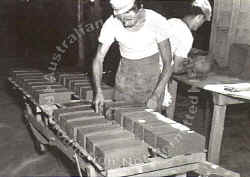 |
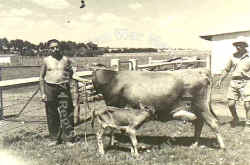 |
|
Hay,
NSW. 1944-01-13/14. 46604
Corporal B. Rivola, an Italian prisoner of war stacking wet bricks
on a barrow at the brick making plant operated by the Italian
prisoners of war at the 16th Garrison Battalion prisoner of war
detention camp. |
Yanco,
NSW. 1944-01-31.
A Jersey cow and her one day old bull calf being shown by Italian
prisoners of war (POWs) at No. 15 POW Camp. |
The prisoners came from everywhere.
There were large numbers of Italians captured in the various North
African campaigns, there were Japanese taken in the Pacific region, as
well as an indistinct group known as 'enemy aliens'. These latter
prisoners included many German Jews who had fled to Britain to avoid
persecution under the Nazis. They were imprisoned in response to a
widespread fear that they included German spies; ironically, many had
originally hoped to join the allied war effort where their many skills
would have been fully utilised.
The first large group of 'enemy
aliens' arrived in Sydney on 7 September 1940. They were taken to a camp
erected near Hay in the south of New South Wales. Here they found
conditions far more tolerable then anything they had so far endured.
Realising that their prisoners wanted to fight the Axis powers as much
as they did many of the Australian camp officials allowed the prisoners
a large degree of liberty.
Very swiftly a school was organised
and a theatrical group formed. Like prisoners everywhere, the 'enemy
aliens' felt a desperate need to keep busy, They received much help and
encouragement in their efforts from various Jewish groups in Australia.
When, eventually, the imprisonment of
these Nazi refugees was seen as a costly blunder, they were given a
choice of either working in Britain or staying in Australia until a more
acceptable location was found. By the end of 1941 few of the original
enemy aliens' from Germany remained in Australia.
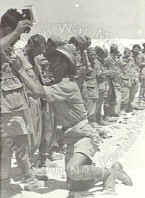 |
El Alamein,
Egypt. 1942-07-18. Italian
prisoners of war being searched by a provost of the 9th
Australian Divisional Provost Company. These prisoners were
captured by units of the 24th Australian infantry brigade during
operations on the night of 1942-07-16 to 1942-07-17, in the
battle area west of El Alamein.
|
By far the largest group of POWs held
in Australia were Italians. These included actual soldiers captured when
fighting in North Africa and merchant seamen who were interned when war
was declared. Altogether some 18 500 Italians were imprisoned in
Australia from May 1941 to December 1947 when the last group was
returned to Italy. A small band of escapees remained at large until
1952.
The first batch of Italian POWs was
also sent to the internment camp at Hay. Later further camps were built
everywhere from Gaythorne in Queensland to Brighton in Tasmania. The
Italians' initial response to their capture varied. Many were simply
glad to be out of the war zone as they had been conscripted into the
army and had no interest in Mussolini's plan for an Italian empire.
Others took their capture more
seriously. Some prisoners had been members of the Fascist Party and
believed it was their duty to Mussolini to try and escape. These
differing attitudes occasionally led to conflict.
ON THE FARMS
|
TOMATO
PICKERS |
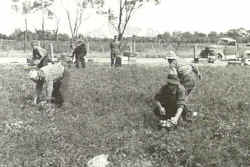 |
Murchison,
Australia. 5 March 1945. View of Italian prisoners of war (POWs)
interned in C Compound, No. 13 POW Group, picking tomatoes on a
property in the Shepparton district where 740 Italian POWs work
daily. An Australian Military Officer is seen, middle background,
on a visit to the pickers to ensure maintenance of output.
|
Early in 1943 it was decided to use
the large number of Italian POWs in Australia to supplement the rural
workforce which had been depleted as a result of war service. The
prisoners were to be paid 10 shillings a week and their keep in return
for which they would work for a farmer. Even there the prisoners
remained under military discipline and were warned that any breaches of
regulations, such as sleeping with Australian women or not wearing their
prison uniforms, would be punished.
An army notice informed participating
farmers that the 'Italian prisoner of war is a curious mixture, in that
he can be made to give of excellent work if certain points are observed;
1. He cannot be driven but he can be
led.
2. Mentality is childlike; it is
possible to gain his confidence by fairness and firmness.
3. Great care must be exercised from
a disciplinary point of view or he can become sly and objectionable if
badly handled.'
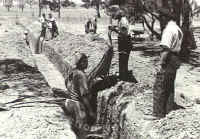 |
These
Italian Prisoners of War are working on installing a new
filtration trench for the septic system at their POW Camp. |
WILLING WORKERS
The Italians turned out to be
generally keen and intelligent workers. Many rural Australians had never
met Italians before and found the experience enlightening. Some began to
learn Italian while others developed a liking for Italian food. Many
prisoners offered to cook at least one Italian meal a week.
One prisoner wrote to his family in
Italy: 1 am with a family of four: parents, a boy and a girl. I am being
treated just like in my own home. 1 have a room for myself with all the
comforts. 1 use their bathroom and basins, I eat with them and they do
the cleaning. In other words I am considered the third child of the
family.'
With the end of the war in August 1945
most of the Italian prisoners believed they would be sent home
immediately. But the first batch of repatriated prisoners did not sail
until July 1946 due to a lack of shipping and the very confused
political situation in Italy. Understandably, the vast majority were
keen to see their families and homes again, some of whom they had not
seen for six years. A large number, however, decided to return to
Australia and settle in areas they had seen or lived in as prisoners.
THE JAPANESE 
Of all the prisoners housed in
Australia during the war the Japanese were undoubtedly the most bitter
and resentful. Under the Japanese rules of war (known as the Bushido
code) prisoners were disgraced persons. Every soldier had an obligation
to die for the Emperor and if the enemy succeeded in capturing him he
was expected to kill himself.
The Australian guards could not even
pretend to understand this attitude and saw most of the Japanese
prisoners as surly and fanatical. Things were not helped when late in
the war information reached Australia about the way the Japanese were
treating Australian prisoners.
It was this mutual incomprehension
between the two races which led to the 'night of a thousand suicides'
when the Japanese in the Cowra prison camp attempted a mass breakout on
5 August 1944. As a result, 231 Japanese and four Australians were
killed. The Australian guards thought the Japanese were attempting to
take over the camp. Actually, they were attempting to kill themselves.
The Australian guards could not even
pretend to understand this attitude and saw most of the Japanese
prisoners as surly and fanatical. Things were not helped when late in
the war information reached Australia about the way the Japanese were
treating Australian prisoners.
Yet there is no evidence to suggest
that the Australian authorities treated the Japanese prisoners any
differently to any other group. Unlike the Italians they were not
permitted to leave the camps to work on the farms but otherwise they
received the same rations and were subject to the same discipline. At no
time was there any attempt to wreak revenge on the Japanese for their
treatment of Australian prisoners. Unfortunately this attitude was
misinterpreted by some of the Japanese as weakness and on several
occasions they pushed matters as far as they could by refusing to work
when ordered, refusing to turn up on parades and refusing to salute
Australian officers. Had Australian prisoners acted in the same fashion
in Japanese POW camps their punishment would have been severe.
Some of this page is an extract from Front Line Dispatches. Bay
Books. ISBN 1 86256 287 3
|